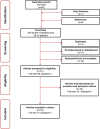Dermatoglyphics in kidney diseases: a review
- PMID: 27066327
- PMCID: PMC4781820
- DOI: 10.1186/s40064-016-1783-7
Dermatoglyphics in kidney diseases: a review
Abstract
Kidney diseases are becoming a major cause of global burden with high mortality and morbidity. The origins of most kidney diseases are known, but for some the exact aetiology is not yet understood. Dermatoglyphics is the scientific study of epidermal ridge patterns and it has been used as a non-invasive diagnostic tool to detect or predict different medical conditions that have foetal origin. However, there have been a limited number of studies that have evaluated a dermatoglyphic relationship in different kidney diseases. The aim of this review was to systematically identify, review and appraise available literature that evaluated an association of different dermatoglyphic variables with kidney diseases. This review is reported according to the Preferred Reporting Items for Systematic Reviews and Meta-Analyses checklist. The PubMed(®) (Medline), POPLINE, Cochrane Library and Trip Database and grey literature sources such as OpenGrey, Google Scholar, and Google were searched to earliest date to 17 April 2014. Of the 36 relevant publications, 15 were included in the review. Of these studies, there are five case reports, seven case series and three comparative studies. Possible association of dermatoglyphics with Wilms tumor (WT) had been evaluated in two comparative studies and one case series that found fewer whorls and a lower mean total ridge count (TRC). Another study evaluated adult polycystic kidney disease (APCD) type III that revealed lower TRC means in all cases. All other case series and case reports describe dermatoglyphics in various kidney disease such as acro-renal-ocular syndrome, potter syndrome, kabuki makeup syndrome, neurofaciodigitorenal syndrome, syndactyly type V, ring chromosome 13 syndrome, trisomy 13 syndrome and sirenomelia. It is evident that whorl pattern frequency and TRC have been used widely to investigate the uncertainty related to the origin of several kidney diseases such as WT and APCD type III. However, small sample sizes, possibly methodological issues, and discrepancy in the make up between cases and control groups limits interpretation of any significant findings. Future studies with proper protocol, adequate cases, and control groups may provide stronger evidence to resolve uncertainty related to the aetiology of kidney diseases.
Keywords: Dermatoglyphics; Kidney disease; Review; Wilms tumour.
Figures
Similar articles
-
Qualitative and quantitative dermatoglyphics of chronic kidney disease of unknown origin (CKDu) in Sri Lanka.J Physiol Anthropol. 2020 Jan 17;39(1):1. doi: 10.1186/s40101-019-0207-0. J Physiol Anthropol. 2020. PMID: 31952553 Free PMC article.
-
The status of dermatoglyphics as a biomarker of Tel Hashomer camptodactyly syndrome: a review of the literature.J Med Case Rep. 2016 Sep 20;10(1):258. doi: 10.1186/s13256-016-1048-7. J Med Case Rep. 2016. PMID: 27650795 Free PMC article. Review.
-
Dermatoglyphics in hypertension: a review.J Physiol Anthropol. 2015 Aug 12;34(1):29. doi: 10.1186/s40101-015-0065-3. J Physiol Anthropol. 2015. PMID: 26265377 Free PMC article. Review.
-
[Dermatoglyphics in families with Potter type III polycystic kidney degeneration].Wien Klin Wochenschr. 1984 Nov 9;96(21):801-4. Wien Klin Wochenschr. 1984. PMID: 6523896 German.
-
Association between pacifier use and breast-feeding, sudden infant death syndrome, infection and dental malocclusion.JBI Libr Syst Rev. 2005;3(6):1-33. doi: 10.11124/01938924-200503060-00001. JBI Libr Syst Rev. 2005. PMID: 27819973
Cited by
-
Dermatoglyphical impressions are different between children and adolescents with normal weight, overweight and obesity: a cross-sectional study.F1000Res. 2019 Jun 25;8:964. doi: 10.12688/f1000research.19471.1. eCollection 2019. F1000Res. 2019. PMID: 32676182 Free PMC article.
-
Qualitative and quantitative dermatoglyphics of chronic kidney disease of unknown origin (CKDu) in Sri Lanka.J Physiol Anthropol. 2020 Jan 17;39(1):1. doi: 10.1186/s40101-019-0207-0. J Physiol Anthropol. 2020. PMID: 31952553 Free PMC article.
References
-
- Abd Allah MAEF, Hany AM, El-Sherief IAE-B (2011) Prediction of genetically predisposed people to renal failure. Ambassad Online Mag 14. http://ambassadors.net/archives/issue29/selected_studies.htm
-
- Babler WJ. Embryologic development of epidermal ridges and their configurations. Birth Defects Orig Artic Ser. 1991;27:95–112. - PubMed
Publication types
LinkOut - more resources
Full Text Sources
Other Literature Sources
Miscellaneous


